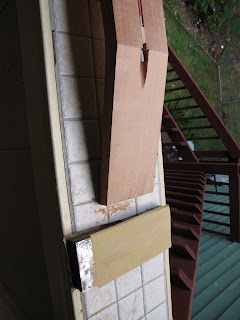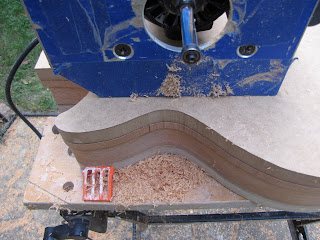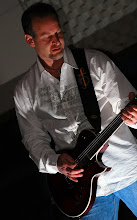I am going to be working on the fret board next. What I am getting from Stew/Mac is a rosewood finger board, Les Paul custom pearl inlays, cream bindings and a vintage bone nut. I have to get get the fret board cut to size and glue the binding on first. Then I am going to install the double action truss rod. As you can see I am only using the Les Paul prints as a guide. No reason to put in the Les Paul style truss rod when you can use the new double action. I actually bought one with a hex nut and I am sending it back for one that uses a allen key. As the double action adjusting rod sets lower in the neck I wont have to go even deeper so the Nut driver will fit around it. The one with the allen nut won't have to have as much carving done on the neck for it be accessible. I will probably have to do a little more shaping on the head stock before I glue the fret board on. After its glued on I will level the fret board with a radius block and do the inlay work. Then I will install the frets.
On a different note I have changed my mind on the pick-ups. I just ordered a DiMarzio LiquiFire DP227 for the neck and a DiMarzio Crunch Lab DP228 for the bridge. These just came out in 2009 and are what John Petrucci is now using.
Straight from DeMarzio's web page referencing the Crunch Lab DP228:
"One thing has stayed consistent throughout John Petrucci’s long and successful career: the DiMarzio® pickups in his guitars. John has been pushing the envelope of progressive metal since the late eighties, and the new DiMarzio® Crunch Lab™ Bridge Model ensued from our most recent collaboration with John. He used it throughout Dream Theater’s tenth studio album, "Black Clouds & Silver Linings.
John swears this is the best live and studio sound he has ever had, and the name says it all - "crunch" is what it’s all about with a big, tight sound that’s neither muddy nor thin".
Tech Talk: The Crunch Lab™ is noteworthy (bad pun alert!) for what it doesn’t do - it’s not a screamer, and it’s not about thundering lows. Its physical appearance is identical to the D Sonic™, but the internal design is a lot different. It’s louder, and the highs have more depth. The lows and mids are more open, and this is crucial for playing chords with body and presence through a gained-out amp. The voicing of the pickup is also different enough to the point that John prefers the Crunch Lab™ to be installed in almost all of his guitars (including the JP Bari) with the solid bar toward the neck, regardless of the guitar’s tuning.
Referencing the LiquiFire DP227:
One thing has stayed consistent throughout John Petrucci’s long and successful career: the DiMarzio® pickups in his guitars. John has been pushing the envelope of progressive metal since the late eighties, and the DiMarzio® LiquiFire™ Neck Model resulted from our most recent collaboration with John. He used it throughout Dream Theater’s tenth studio album, "Black Clouds & Silver Linings".
John swears this is the best live and studio sound he has ever had. He wanted a neck pickup with a flowing, singing solo tone when used with a heavily overdriven amp and a clear chord sound with a clean amp setting.
Tech Talk: Since the mid 1990s, John’s neck pickup sound has been based on either the standard Air Norton™ or the custom version in his Ernie Ball® guitars. The LiquiFire™ has several significant differences. Its treble response is warmer and smoother while bass response is tighter and brighter. The total sound has a more focused voice which works equally well for highly overdriven solos and complex, clean chords.
Once those come in (from Sweetwater.com) I can think about routing out the cavities for them in the body.










































